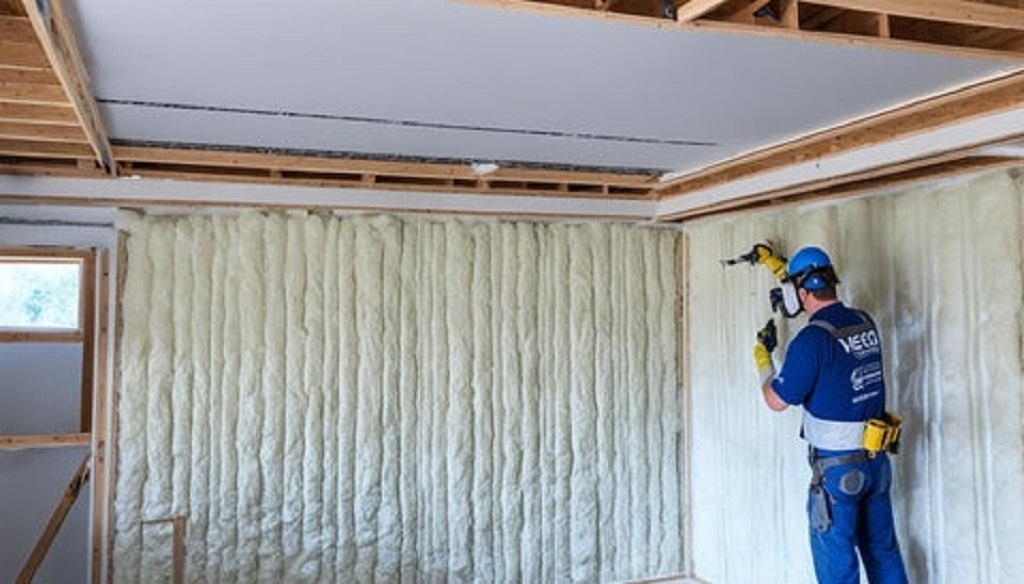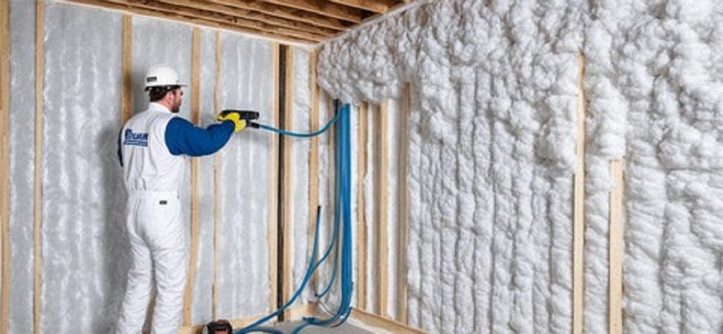Your home deserves comfort and efficiency. Spray foam insulation delivers both. It seals gaps, reduces energy bills, and keeps indoor temperatures steady. With rising energy costs, proper insulation is a smart investment. According to the U.S. Department of Energy, heating and cooling account for 50–70% of home energy use. Well-insulated homes can save up to 20% on monthly energy bills. Spray foam stands out among insulation choices for its high R-value and versatility. But how do you pick the right type? This guide breaks down the process, covering types of spray foam, benefits, and practical tips to ensure your home stays cozy and energy-efficient.
What Is Spray Foam Insulation?
Spray foam insulation is a foam-based insulation applied as a liquid. It expands to fill gaps, creating a tight seal. Unlike traditional insulations like fiberglass batt insulation or loose fill fiberglass, spray foam offers superior resistance to heat flow. It’s ideal for exterior walls, attics, and floor joists. The two main types are open cell spray foam and closed cell spray foam. Each has unique properties, making them suitable for different needs. Choosing the right one depends on your home’s structure, climate zone, and budget. Let’s explore the key differences and benefits to help you make an informed decision.
Types of Spray Foam Insulation
Spray foam comes in two primary forms: open cell and closed cell. Both improve energy efficiency, but they differ in density, R-value, and cost. Understanding these differences is key to selecting the best option for your home.
Open Cell Spray Foam
Open cell spray foam is lighter and less dense. It has a spongy texture and is more affordable. Its R-value measures around 3.5–3.8 per inch, making it less effective at stopping heat transfer than closed cell foam. However, it excels as a sound barrier and is ideal for interior walls or attic floors. It’s also more flexible, which helps in homes prone to settling or movement. Open cell foam is a great choice for those seeking affordable insulation types without sacrificing quality.
- Pros: Cost-effective, good sound insulation, flexible.
- Cons: Lower R-value, not a moisture barrier.
Closed Cell Spray Foam
Closed cell spray foam is denser and more rigid. It offers an excellent R-value of 6–7 per inch, making it highly effective at reducing heat flow. It also acts as a moisture barrier, preventing moisture issues in areas like basements or crawl spaces. Closed cell foam is pricier but provides better insulation performance for exterior walls or roof insulation options. It’s a top choice for colder climates or homes needing high-quality insulation. Its strength adds structural support, making it ideal for construction homes.
- Pros: High R-value, moisture control, structural support.
- Cons: Higher cost, less sound insulation.
Key Factors to Consider When Choosing Spray Foam Insulation

Selecting the right spray foam involves evaluating your home’s needs. Here are the main factors to guide your decision:
1. Climate Zone
Your climate zone determines the recommended R-values for insulation. The U.S. Department of Energy provides guidelines for minimum R-value requirements. For example, colder climates need higher R-values (R-38 to R-60 for attics) to keep homes warm. Closed cell spray foam is better for extreme temperatures due to its superior resistance. In milder climates, open cell foam may suffice. Check your local building codes to ensure compliance with insulation requirements.
2. Area of Installation
Different areas of your home require specific insulation types. For a wall cavity or 2-by-4 wall cavity, closed cell foam maximizes insulation in tight spaces. Open cell foam works well for attic floors or interior walls where soundproofing is a priority. Floor joists or crawl spaces benefit from closed cell foam’s moisture control. Consider the space and its unique needs before deciding.
3. Budget
Closed cell foam costs more due to its density and performance. Open cell foam is a budget-friendly option for those seeking savings on energy bills without high upfront costs. Balance cost with long-term energy efficiency impacts. Investing in high-quality insulation now can reduce monthly energy bills significantly.
4. Moisture Control Needs
Moisture issues can damage homes. Closed cell spray foam acts as a moisture barrier, making it ideal for basements or areas prone to dampness. Open cell foam is not water-resistant and may require additional vapor barriers. If moisture control is a concern, prioritize closed cell foam or combine insulation with a barrier.
5. Energy Efficiency Goals
Spray foam is known for creating an energy-efficient home. Its ability to seal gaps reduces air leaks, keeping indoor temperatures steady. Closed cell foam offers greater reductions in energy bills due to its higher R-value. If energy consumption is a top priority, closed cell foam is the better choice.
6. Professional Installation
Proper installation is critical for insulation performance. A professional insulation contractor ensures the foam is applied correctly, achieving the intended R-value. Poor installation can lead to compressed insulation or gaps, reducing effectiveness. Hire a licensed contractor with experience in spray foam to avoid costly mistakes.
Benefits Beyond Energy Efficiency
Spray foam insulation offers more than just energy savings. Its unique properties provide additional advantages:
- Improved Comfort: Eliminates cold floors and uneven temperatures, creating a comfortable home.
- Soundproofing: Open cell foam reduces noise, perfect for urban homes or busy areas.
- Structural Strength: Closed cell foam adds rigidity to walls, enhancing durability.
- Moisture Protection: Closed cell foam prevents water damage, ideal for humid climates.
- Longevity: Spray foam lasts decades without settling, unlike traditional insulations.
These benefits make spray foam a top choice for homeowners seeking a well-insulated home with added value.
Comparing Spray Foam to Other Insulation Types
Spray foam isn’t the only option. Let’s compare it to other common wall insulation options to see how it stacks up.
Fiberglass Batt Insulation
Fiberglass batt insulation is affordable and widely used. It comes in pre-cut sheets and fits standard wall cavities. However, it has a lower R-value (3–4 per inch) and doesn’t seal gaps as effectively. It’s prone to settling and may require extra fiberglass for optimal performance.
Blown-In Insulation
Blown-in insulation, like dense-packed cellulose or loose fill fiberglass, is great for attics or irregular spaces. It offers decent R-values (3–4 per inch) but requires professional installation to avoid settling. Unlike spray foam, it doesn’t provide a moisture barrier.
Denim Insulation
Denim insulation is eco-friendly and made from recycled materials. It’s non-water sensitive and offers good soundproofing. However, its R-value (3.5–4 per inch) is lower than closed cell foam, and it’s less effective at sealing air leaks.
Spray foam outperforms these options in R-value and air sealing, making it a premium choice for energy-efficient homes.
How to Ensure Proper Installation
Proper installation maximizes the effectiveness of insulation. Follow these steps to get it right:
- Hire a Professional: Choose a licensed contractor with spray foam experience.
- Check R-Value Requirements: Confirm the insulation meets your climate zone’s standards.
- Inspect the Area: Ensure walls, attics, or floors are clean and dry before application.
- Verify Foam Type: Confirm whether open or closed cell foam is being used.
- Monitor Application: Ensure even coverage without gaps or over-application.
A professional contractor will handle these steps, ensuring a comfortable and energy-efficient home.
Cost vs. Savings: Is Spray Foam Worth It?
Spray foam insulation has a higher upfront cost than traditional options. Open cell foam costs $0.44–$0.65 per square foot, while closed cell foam ranges from $1–$2 per square foot. However, the savings on energy bills can offset the cost. According to Energy Star, proper insulation can save homeowners $200–$400 annually. Over 10 years, that’s $2,000–$4,000 in savings. For a 2,000-square-foot home, spray foam installation might cost $2,000–$8,000, but the long-term benefits—energy savings, comfort, and durability—make it a worthwhile investment.
Common Mistakes to Avoid
Choosing spray foam insulation is a big decision. Avoid these pitfalls to ensure success:
- Skipping Professional Installation: DIY can lead to uneven application and reduced R-value.
- Ignoring Climate Needs: Using open cell foam in cold climates may not meet minimum R-value standards.
- Overlooking Moisture Issues: Failing to address dampness can cause mold with open cell foam.
- Choosing Based on Cost Alone: Cheaper options may not deliver long-term savings.
- Neglecting Ventilation: Proper airflow prevents moisture buildup, especially with closed cell foam.
By avoiding these mistakes, you ensure your insulation performs at its best.
Case Study: A Real-World Example
Meet Sarah, a homeowner in a colder climate. Her old home had fiberglass batt insulation, but cold floors and high energy bills were constant issues. She hired a professional insulation contractor to install closed cell spray foam in her exterior walls and attic. The contractor used 6-inch insulation to achieve an R-value of 42, exceeding her climate zone’s requirements. After installation, Sarah’s energy bills dropped by 25%, and her home stayed warm even in harsh winters. The added moisture barrier also prevented basement dampness. Sarah’s story shows how spray foam can transform a home’s comfort and efficiency.
FAQs
What Is the Difference Between Open and Closed Cell Spray Foam?
Open cell foam is lighter, less expensive, and better for soundproofing. Closed cell foam is denser, has a higher R-value, and acts as a moisture barrier. Choose based on your budget and insulation needs.
Is Spray Foam Insulation Worth the Cost?
Yes, spray foam offers significant energy savings and comfort. It can reduce energy bills by up to 20%, offsetting the higher upfront cost over time.
Can Spray Foam Be Used in Any Climate?
Yes, but closed cell foam is better for colder climates due to its higher R-value. Open cell foam suits milder climates or interior applications.
Does Spray Foam Insulation Help With Moisture Control?
Closed cell foam acts as a moisture barrier, preventing water damage. Open cell foam requires additional vapor barriers in humid areas.
How Do I Find a Reliable Insulation Contractor?
Look for licensed contractors with spray foam experience. Check reviews, ask for references, and verify they follow local building codes.
Read More Also: Crafting Your Dream Space: Expert Bathroom Remodeling
Conclusion: Make Your Home Energy-Efficient Today
Spray foam insulation is a powerful way to boost your home’s comfort and efficiency. Open cell foam offers affordability and soundproofing, while closed cell foam delivers superior R-value and moisture control. Consider your climate, budget, and installation needs when choosing. Proper installation by a professional ensures maximum performance. With spray foam, you’ll save money on energy bills, enjoy a cozier home, and protect against moisture issues. Ready to get started? Contact a professional insulation contractor today to explore your options and create a comfortable, energy-efficient home.
References
- U.S. Department of Energy: https://www.energy.gov/energysaver/insulation
- Energy Star: https://www.energystar.gov/saveathome/heating_cooling
- Building America Solution Center: https://basc.pnnl.gov/resource-guides/spray-foam-insulation





Leave a Reply